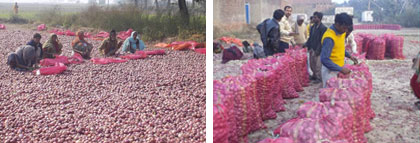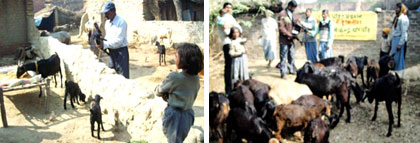Success Story
Floriculture along with Vermicompost production a profitable enterprise
Crop diversification is the need of the hour as floriculture is very remunerative now days .Farmers have been repeatedly and unconsciously using the chemical fertilizers and pesticides for crop production. Due to this, our soil as well as environment is becoming harmful that is exerting its detrimental effects on general people. Some farmers are very conscious about this fact and hence they are being diverted towards organic agriculture which is the solution of present day.
Few years ago, Mr.Ramesh Kumar S/o Late Shri Chandra pal Singh, village Hasanpur Akodia Block-Airayan, Fatehpur visited to KVK Thariaon, Fatehpur and got training in floriculture and Vermicompost production. He was so happy with guidance of KVK Fatehpur that he immediately started Vermicompost production at his farm/residence. He got 3 kg earthworms(redworms i.e. Isenia foeitida) from KVK, Fathepur. Earlier he started Vermicomposting in open ground under tree shade, simultaneously he started floriculture also. The experiment was very successful. Next year he established well developed vermicompost unit of 12x4x1 ft with an area of 48 ft2 with 7 beds total area 336 ft2, each of 12 ft X 4 ft X1 ft dimension. The area was covered with net under the trees shade.
Today he is producing about 2800 kg of vermicompost per year from the said 7 beds. About 1000 kg vermicompost is sold in the market (Fatehpur and Allahabad) @ Rs.8.00/kg, earning Rs.8000.00 /year. Rest 1800 kg of vermicompost is used in his fiowerbeds as well as crops crop fields(Wheat, Vegetables andbannana, floriculture etc.).
Economics of Vermicompost production
(A) Production
Total covered area under trees = 336 ft2
No.of vermibeds = 7
One vermibed = 12 ft X 4 ft X 1 ft
Total vermibed area = 48 ft2
Vermicompost production = 2800 kg (2.8 tons)
(B) Expenditure
Construction cost (Permanent) = Rs.10500.00
Cost of cattle dung = Nil (Own animals)
Miscellaneous cost = Rs.2500.00
(C) Income
Selling of 1000 kg vermicompost @ Rs.8.00/kg = Rs.8000.00
Selling of 5 kg worms @ Rs.200.00/kg = Rs.1000.00
1800 kg vermicompost kept for own farming
Equivalent income of vermicompost used in farming= Rs.12000.00
Total Income = Rs.21000.00
Net Income = Rs.21000.00-Rs.2500.00 = Rs.18500.00
Thus, Mr.Ramesh Kumar is earning Rs.18500.00 per year as an additional income from only 336 ft2 area. At the same time he has got fame in floriculture cultivation and converting his farm in to organic farm .
Horizontal Spread Taking the lesson from Mr.Ramesh Singh, other farmers of the district are taking interest in vermicomposting. Presently 10 farmers of district Fatehpur have established vermicompost units in backyard of their houses and are producing vermicompost successfully.

Banana Cultivation is Highly Remunerative in Fatehpur
District Fatehpur is lying between the holy rivers Ganga and Yamuna. It falls between two metro cities Kanpur and Allahabad. Agro-ecological situations of Fatehpur are very favourable for banana cultivation. 9-10 years ago some farmers i.e. Shri Ram Singh of Vill.-Bharatpur, Shri Abhishek Singh Chauhan of Budhaiyapur, Shri Sallimmuddin of Bilinda and Shri Moti Singh Yadav of Vill.-Bharatpur, Fatehpur approached to KVK, Fatehpur for technical guidance and input needs. Then they started banana cultivation and now they are gaining more and more from this venture.
Technology Responsible for its Success
- Introduction of tissue culture Banana variety - G-9.
- Transplanting of suckers at right time.
- Introduction of IPNM and IPM technologies in banana.
- Inclusion of Cucurbits as intercrop in early stage.
Effect of the Technology
Productivity : The yield of tissue culture banana ranged from 2500-3000 q/ha in comparison to 1500-1800 q/ha from local banana varieties.
Economics :
1.Per hectare Expenditure
a. Tissue culture/suckers : Rs.85000
b. Chemical fertilizers : Rs.74000
c. Irrigation Charges : Rs.40000
d. Plant protection : Rs.5000
e. Labour & other charges : Rs. 20000
Total Expenditure - Rs. 224000/ha
2.Gross Income : Rs. 650000/ha
3.Net Income : Rs. 426000/ha
4.C:B ratio : 1:2.90
Suitability in the existing farming/cropping systems: Being profitable intervention, it provides higher return than cereals. Farmers also take cucurbits as intercrop in banana in the early stages.
Acceptance of technology by the farmers : Banana var.‘G-9’ is performing better than the traditional verities. Tissue culture with IPNM & IPM proved to be highly remunerative to the farmers of district Fatehpur.
Horizontal Spread : Due to technical assistance from KVK, Fatehpur and input support from National Horticulture Mission & DASP, farmers have sown their keen interest in banana crop. Consequently the area in the district increased from 70-75 ha in 2001-02 to about 30000 ha in 2011-12.
Replacement of Crops : Area under banana is increasing on the cost of Paddy and Wheat area.
Social impact: Because of higher net return /ha, farmers put their more and more area under banana cultivation.
Marketing Channels : Banana is sold in nearby Kanpur mandi directly. Also, traders from different metropolitan cities approach directly to the growers and offer reasonable prices at the fields itself.
Need for establishment of processing units: As the area under banana cultivation is increasing day by day, the farmers are feeling need of establishing processing plants in Fatehpur for getting better prices of their banana produce.

Onion Production Enhanced the Economic Status of the Farmers
District Fatehpur is having vast opportunity of vegetable production. The scientist of the KVK, Thariaon, Fathepur under the scheme of crop diversification trained the farmers in raising the onion in Kharif season. Some farmers of the district took lead and started onion production under the guidance of KVK.
Shri Dinesh Singh S/o Rajbahadur of Village-Katoghan and Ram Singh S/o Sobran Singh of Village-Bharatpur were provided with 10 kg seed of onion var.Agrifound Dark Red. The seed of said variety was provided to them from Nasic, Maharastra by the horticulture scientist of KVK, Fatehpur in 2008. They planted it in one ha and produced about 300-350 qt/ha and 250-300 qt/ha in Rabi & Kharif season, respectively. They earned on an average a net profit of Rs.65000 and Rs.75000 per ha in Rabi and Kahrif seasons, respectively. Next year also they earned almost the same net profit.
Last year in 2010 when the cost of onion produced was very high (Rs.2000-2200) they sold the onion at Rs. 1800 per qt. to the traders and thus earned about Rs.500000 in Kharif season and around Rs.400000 in Rabi season as their gross income. This time also in 2011 when the prices of onion are about Rs.600-700 per qt., they have earned Rs.200000 in Kharif season and Rs.150000 per ha. The cost of one ha. onion production, on an average is Rs.64000-68000.
The said farmers inspired other formers of the district and the area under onion is increasing day by day. Today the total area of district Fatehpur under onion is 10000 ha. of which 4000 area is under Rabi season.

Goat Keeping is profitable for the Farmers
- Background about case or problem : Mr.Lalchand S/O Sri Rampal of Fatehpur is a marginal farmer cultivating mainly wheat/Gram/Paddy/Arahar and could hardly obtain Cereals and Pulses for its own consumption round the year.Sometimes he could not manage to harvest better yield.As he also had one or two local Goats for some milk.During the visit to KVK he was advised to upgrade the local Goats by Barbari breed.On the on set of heat he brought his Goats for natural mating to KVK and the kids born in future were maintained and the Goat population increased at his home.
- Technology/process which was intervened for its success : Upgradation of local goat through natural mating by KVK Barbari bucks and timely deworming and proper management practices viz. feeding mustard oil with turmeric powder one tea spoon to kids just after kidding, deworming at the age of ten days, 30 days and 90 days along with twice annual deworming to the adult goats.
- Effect of the technology/process on.
- Production : Due to breeding by Barbari improved breed was obtained which produced twins in a year.
- Productivity : The average milk produced by graded goats(1-2.25 lt/day ) was higher than the local breed(0.5-1 lt/day).
- Economic gains : 1. Per/Unit Expenditure as he started the unit with only two Goats cost Rs.3000.Average cost of maintenance was low as the goats were allowed for grazing only little amount of concentrate was offered along with medication(average cost on 8-10 goats/year ranged fromRs.1000-1200) 2. Gross Income - Rs. 9500-10000/year 3. Net Income - Rs. 8500-9000/year 4. C:B ratio - 1:3.00
- Suitability in the existing farming/cropping systems : Being a marginal farmer Goat keeping was be fitting with his farming system.
- Acceptance of technology/process in terms of views of the farmers : The Farmers of the village also approached KVK for upgradation of Goats and adopted the technology of timely deworming and proper management.
- Horizontal spread : Presently 15-18 families have opted Goat farming in the village.
- Substitution or replacement of commodities : Non descript local Goats .
- Social impact : The Farmers of the village doing Goat farming along with crops are earning additional income every year and in need of money in spite of borrowing from ‘Sahukars’ they sell the male and meet out their urgent needs.
- Marketing channels : Before the ‘Bakri Eid’ festival purchasers collect the males from the village or sometimes they are sold in the open market.
- Establishment of process/units : The units are established through the help of KVK
- Linkage with technology/development organizations : The Farmers of the area are having strong linkage with the KVK and Veterinary Deptt.
- Place and Address of Concern Farmers : Sri Lalchand S/O Sri Ram Pal,Village –Jaisinghpur, Block –Haswa, District - Fatehpur


